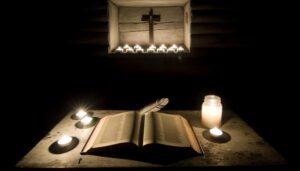Bow Meaning in the Bible: Covenant and Warfare
In the Bible, the term ‘bow’ carries deep symbolism across different contexts. It signifies God’s covenant with Noah, where the rainbow represents His promise never to flood the earth again, highlighting divine mercy and faithfulness (Genesis 9:8-17).
Additionally, the bow symbolizes authority and power, often seen in military contexts, reflecting both divine intervention and human prowess. In prophetic literature, it conveys divine judgment and eschatological themes (Revelation 6:2).
Moreover, the bow as a hunting tool emphasizes survival and humanity’s dominion over creation. Each instance weaves together theological insights and historical contexts, revealing profound spiritual meanings.
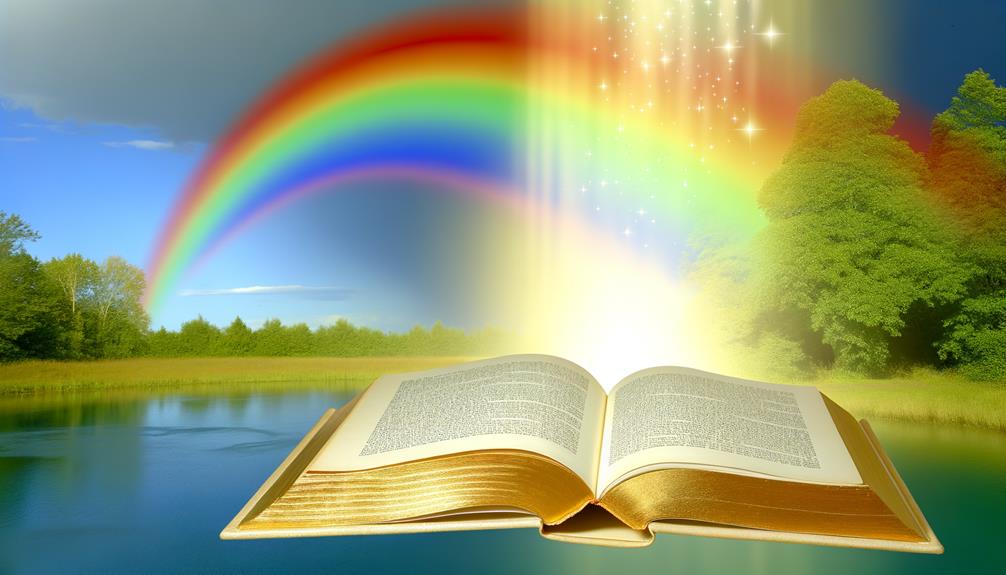
Bow Meaning in the Bible: Symbolism of Covenant, Strength, and Judgment
| Aspect | Details |
|---|---|
| Definition | A weapon for battle or a sign of covenant in scripture |
| Biblical References | Genesis 9:13 – Rainbow as God’s covenant with Noah; Psalm 7:12 – God’s bow in judgment |
| Symbolism | Covenant (rainbow), warfare (weapon), strength, and divine justice |
| God’s Bow in Judgment | Habakkuk 3:9 – God’s bow prepared for battle against evil |
| Spiritual Lesson | God is both a protector and a righteous judge, offering mercy and justice |
God’s Covenant With Noah

In the biblical narrative of Genesis, God’s covenant with Noah following the Flood is marked by the appearance of a rainbow, symbolizing His promise never to destroy the earth by water again. This event occurs in Genesis 9:8-17, where God establishes a unilateral covenant, binding Himself to humanity and all living creatures.
Historically, this covenant marks a pivotal moment in the postdiluvian world, representing a shift from divine judgment to divine mercy.
Theologically, the rainbow serves as an enduring sign of God’s faithfulness and grace, transcending human sinfulness. The covenant with Noah underscores a fundamental aspect of God’s character—His commitment to creation and His desire for a relationship with humanity, despite their imperfections.
Symbol of Divine Promise

In the biblical narrative, the bow holds profound significance as a symbol of divine promise, particularly in the context of God’s covenant with Noah following the Flood.
This covenant, marked by the appearance of a rainbow, serves not only as a divine assurance against future global deluges but also as an enduring sign of hope and reconciliation between God and humanity.
Theologically, the rainbow encapsulates God’s unwavering commitment to uphold creation, reflecting an everlasting bond of trust and mercy.
Covenant With Noah
Following the great flood, the bow in the sky served as a profound symbol of God’s covenant with Noah, representing an enduring divine promise to never again destroy the earth with a flood. This covenant, detailed in Genesis 9:12-17, marked a pivotal moment in biblical history, establishing a divine assurance that transcended human frailty and sin.
Theologically, the rainbow served as a tangible reminder of God’s mercy and faithfulness.
- Biblical Context: Genesis 9:13 states, ‘I have set my bow in the cloud, and it shall be a sign of the covenant.’
- Symbolism: The bow reflects God’s commitment to creation’s preservation.
Sign of Hope
As a symbol of divine promise, the bow in the sky emerges as a beacon of hope, encapsulating God’s unwavering commitment to humanity and the natural world.
This imagery finds its roots in the Genesis account, where God places a rainbow after the Flood to signify His covenant with Noah (Genesis 9:12-17). Historically, this act represented a divine assurance that never again would a deluge destroy all life.
Theologically, the rainbow serves as a recurring reminder of God’s mercy and faithfulness. It underscores the belief in a benevolent Creator who honors His promises, offering solace and hope to believers.
This symbolism has permeated religious thought, portraying the bow as an emblem of divine grace and protection throughout biblical history.
Bow as a Weapon
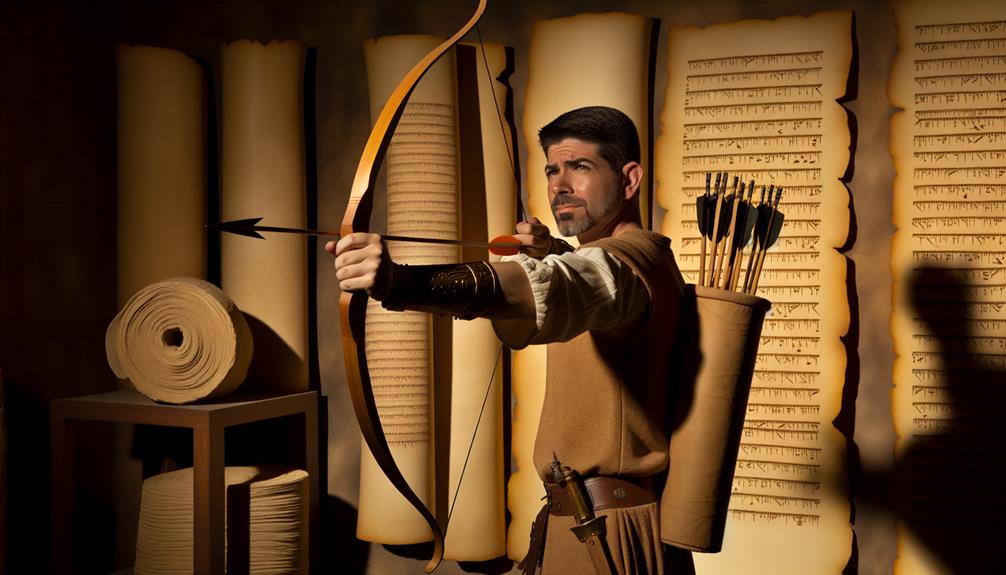
In the ancient biblical context, the bow was not merely a physical weapon but also a potent symbol of power and authority.
Throughout various scriptures, the bow is often associated with military strategies, reflecting the sophistication and tactical prowess of ancient armies.
Theologically, it underscores the divine sanction of warfare and the might of those chosen to wield it, encapsulating both human and divine aspects of conflict and protection.
Ancient Biblical Context
The bow, frequently referenced in ancient biblical texts, served as an essential instrument of warfare and hunting, symbolizing both divine judgment and protection in the historical and theological landscape of the Bible. Understanding its significance requires a detailed analysis of its multifaceted roles within ancient Israelite society:
Warfare: The bow was a primary weapon for soldiers, mentioned in narratives like the exploits of archers in 2 Samuel 22:35.
Hunting: It was also vital for subsistence, as illustrated in Genesis 21:20 where Ishmael becomes a skilled archer.
Divine Instruments: The bow is metaphorically linked to God’s power, as seen in Habakkuk 3:9, depicting God’s readiness for divine intervention.
These contexts underscore the bow’s profound impact on biblical history and theology.
Symbolism of Power
Emphasizing the bow’s role as a symbol of power, we observe its depiction as an extension of divine authority and human might throughout biblical narratives. The bow is not merely a physical weapon but a potent emblem of strength and sovereignty.
In Psalms, the bow symbolizes God’s protection and judgment, underscoring divine omnipotence. Similarly, warriors like King David wield the bow to signify their martial prowess and divine favor. This duality of divine and human power is evident in various scriptures.
| Scripture | Symbolism | Context |
|---|---|---|
| Psalms 7:12-13 | Divine Judgment | God’s readiness to punish evil |
| 1 Samuel 18:4 | Royal Authority | Jonathan gifts David his bow |
| Habakkuk 3:9 | Divine Wrath | God’s preparation for battle |
This integration underlines the bow’s multifaceted role in biblical symbolism.
Military Strategies Described
Biblical accounts frequently highlight the strategic importance of the bow in ancient military engagements, illustrating its effectiveness in both offensive and defensive maneuvers.
The bow allowed armies to project force from a distance, a critical advantage in numerous biblical battles. In historical context, bows enabled smaller forces to repel larger armies and fortified cities to defend against sieges.
From a theological perspective, the bow’s mention often underscores divine empowerment and protection, as seen in David’s reliance on God’s strength in Psalms.
- Offensive Tactics: Archers could weaken enemy lines before direct combat.
- Defensive Strategies: Defenders on city walls used bows to repel invaders.
Bow in Warfare
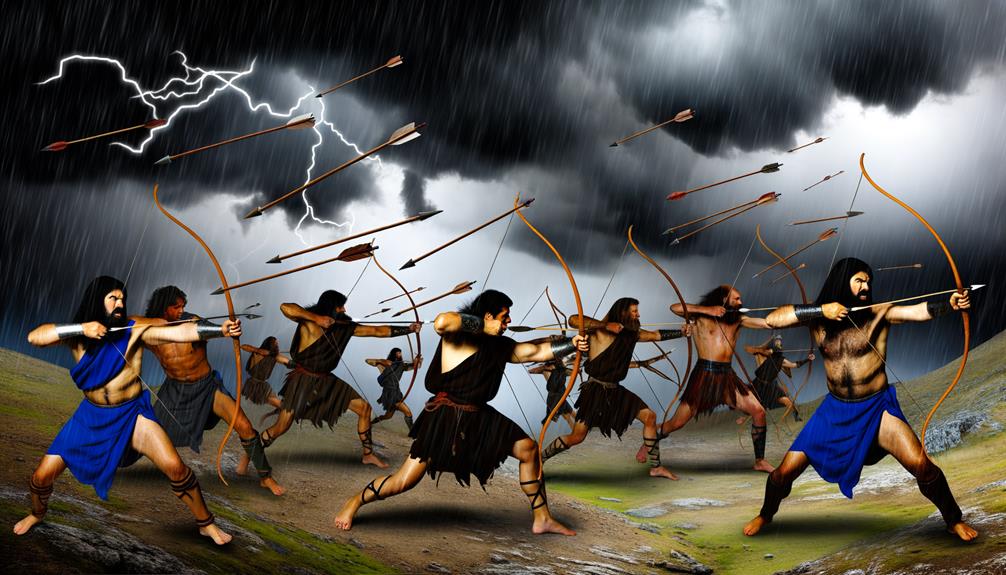
In the context of ancient warfare, the bow emerges as a pivotal instrument of combat, symbolizing both divine intervention and human prowess in the biblical narrative. Its significance is underscored in various scriptures, where it serves not only as a weapon of physical conflict but also as a metaphor for God’s strength and protection. The bow’s utility in warfare showcases technological advancement and strategic military planning of the era.
| Scriptural Reference | Significance |
|---|---|
| 1 Samuel 18:4 | Jonathan’s bow symbolizing covenant |
| Psalm 18:34 | God training hands for battle |
| Zechariah 9:13 | Judah as God’s bow |
| 2 Samuel 1:18 | Lamenting the use of bow |
These references highlight the bow’s dual role in both divine and human contexts.
Hunters and the Bow

In biblical narratives, hunters such as Nimrod and Esau are often depicted wielding the bow, underscoring its significance as a tool for survival and dominion over nature.
The bow’s symbolism extends beyond its practical use, representing themes of providence, skill, and occasionally, divine judgment.
Analyzing these archetypes and the multifaceted symbolism of the bow reveals deeper theological insights into humanity’s relationship with creation and divine order.
Biblical Hunter Archetypes
How does the bow, a weapon of both survival and warfare, shape the archetype of the hunter within the tapestry of Biblical narrative and theological symbolism? The bow features prominently in the lives of several Biblical figures, illustrating their roles as providers and warriors.
Nimrod, described as a mighty hunter before the Lord, exemplifies the primal archetype of the hunter whose prowess with the bow signifies dominion and skill. His identity as a hunter underscores themes of leadership and rebellion.
Esau, a skilled archer, contrasts sharply with his brother Jacob’s domesticity. This reflects the tension between wilderness and civilization.
Ishmael is also depicted as an archer, symbolizing survival and divine providence in the wilderness.
These archetypes enrich the Biblical narrative with layers of cultural and theological meaning.
Symbolism of the Bow
The bow in Biblical symbolism transcends its utilitarian function, embodying themes of divine judgment, covenant, and the human struggle for survival and mastery.
Historically, the bow was an essential tool for hunters, reflecting humanity’s reliance on skill and providence to secure sustenance.
In theological terms, the bow signifies God’s covenant with Noah, as a rainbow, symbolizing divine promise (Genesis 9:13).
Simultaneously, it represents divine judgment, as seen in various prophetic imagery where God’s bow is poised against transgressors (Habakkuk 3:9).
The duality of the bow encapsulates both protection and peril, mirroring the broader biblical narrative of human dependence on divine favor and the constant vigilance required to uphold righteousness in a world fraught with moral challenges.
Bow in Prophetic Visions

Throughout biblical prophetic visions, the bow frequently emerges as a symbol of divine judgment and covenant, offering profound theological insights into God’s relationship with humanity.
This imagery often underscores themes of divine retribution and promises, reflecting the multifaceted nature of God’s interactions with His people.
- Judgment: In Revelation 6:2, the bow is held by the rider on the white horse, symbolizing conquest and divine judgment upon the earth.
- Covenant: Genesis 9:13 features the rainbow as God’s covenant with Noah, representing His promise never to flood the earth again.
These instances reveal the bow’s dual role in prophecy, intertwining justice and mercy.
Bow in Psalms

In the Psalms, the bow is frequently invoked as a powerful metaphor, reflecting aspects of divine strength, protection, and the psalmist’s reliance on God’s deliverance.
Historically, the bow was a symbol of military might and defense, integral to ancient warfare. Psalms such as Psalm 7:12 and Psalm 18:34 illustrate how the bow signifies God’s preparedness to enact justice and His empowering presence in battles faced by the faithful.
Theologically, the bow represents God’s omnipotence and the assurance that He equips believers with spiritual fortitude.
This imagery not only underscores God’s role as a divine warrior but also resonates with the psalmist’s profound trust in God’s sovereign ability to shield and sustain His people.
Bow and Deliverance

Central to the theme of deliverance, the bow in biblical narratives often symbolizes God’s intervention and salvation for His people, reflecting a divine commitment to rescue and restore those who trust in Him. This powerful imagery is exemplified in several key instances within the scriptures:
- Noah’s Ark: Post-flood, the rainbow signifies God’s covenant of deliverance from future global destruction (Genesis 9:13-17).
- David’s Psalms: The bow is depicted as a weapon of deliverance, symbolizing God’s protection and victory over enemies (Psalm 7:12).
These examples underscore the bow’s profound role in illustrating divine deliverance throughout biblical history.
Bow in Revelation

The Book of Revelation employs the imagery of the bow to convey themes of divine judgment and eschatological conflict, encapsulating the ultimate triumph of God’s will over cosmic forces of evil.
This imagery is particularly evident in Revelation 6:2, where the rider on the white horse wields a bow, symbolizing conquest and the impending divine retribution.
Historically, the bow was a powerful weapon, underscoring the severity and inevitability of God’s judgment. Theologically, the bow in Revelation serves to remind believers of the sovereign power of God in the unfolding of end-time events.
| Symbol | Reference |
|---|---|
| Bow | Revelation 6:2 |
| Rider | White Horse |
| Theme | Divine Judgment |
| Context | Eschatology |
This detailed analysis underscores the biblical significance and theological weight of the bow in Revelation.
Bow as a Sign

Often depicted in Scripture, the bow serves as a multifaceted sign, symbolizing both divine promise and covenant as seen in Genesis 9:13, where God sets the rainbow in the clouds as a perpetual sign of His covenant with all living creatures. This emblem not only signifies divine assurance but also carries historical and theological depth:
- Divine Assurance: The rainbow reassures humanity that God will not destroy the earth by flood again.
- Covenantal Symbol: It represents a binding agreement between God and His creation.
This all-encompassing symbol intertwines historical context with theological insight, emphasizing its enduring relevance in biblical narratives.
Spiritual Significance
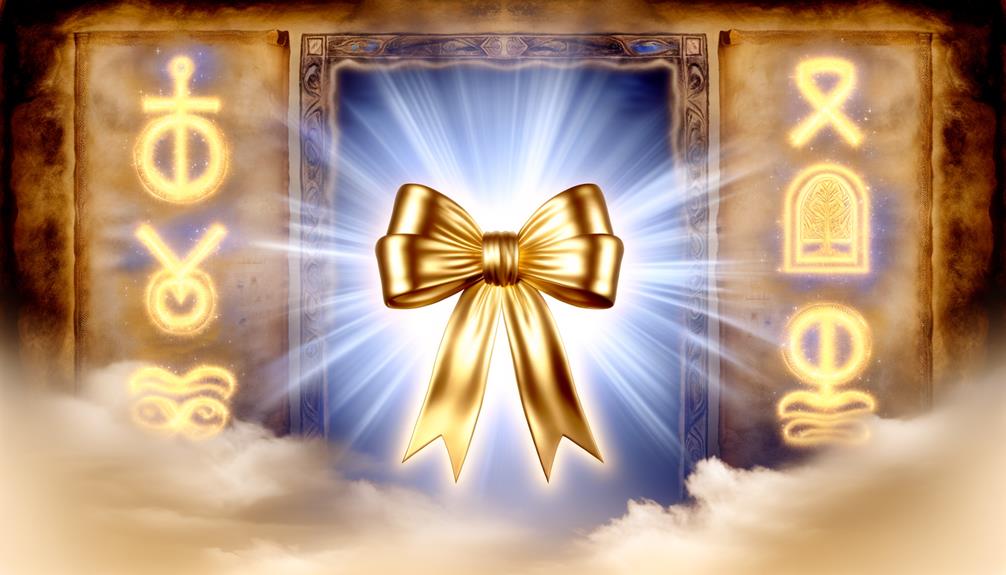
In the Bible, the bow transcends its physical representation to embody profound spiritual significance, illustrating divine protection, judgment, and salvation throughout various scriptural narratives.
In Genesis 9:13, God sets a bow in the clouds as a covenantal sign, symbolizing divine mercy and the promise to never again flood the earth.
Conversely, in Psalms and prophetic literature, the bow often represents divine judgment and warfare, as seen in Psalm 7:12, where God readies His bow against the wicked.
Theologically, the bow serves as a dual emblem of God’s justice and grace, encapsulating the complex relationship between divine retribution and benevolence.
This rich symbolism invites believers to reflect on the multifaceted nature of God’s interaction with humanity.
Conclusion
The multifaceted symbolism of the bow in biblical texts reveals a profound tapestry of divine promise, martial prowess, and spiritual significance.
Examined through the prism of historical context and theological insight, the bow emerges not merely as a physical implement but as a potent metaphor for covenant, protection, and eschatological revelation.
This emblematic instrument encapsulates the intricate interplay between divine assurance and human agency, offering a compelling lens through which to interpret sacred scripture.






